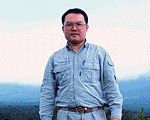Staff
|
|
|
|
 |
|
Wu, Sheng-Hua
Curator
Retirement
Biology
|
E-mail
shwu@mail.nmns.edu.tw
| Academic Achievements I am conducting taxonomic research on lignicolous Basidiomycotina, with special emphasis on the order Aphyllophorales. Wood-decaying fungi decompose the cellulose, hemicelluloses, and lignins of the wood cell wall. In this way, they promote the recycling of natural materials, and thus play an important decomposition role in forest ecology. Among the wood-decaying fungi, many species have food or medicinal value. Domestic wood-decaying Basidiomycetes total up to 2,000 species. However, less than 1/3 of these are known. Therefore, there is much work to be done to finish their survey.
My work with lignicolous Basidiomycotina began in 1987, when I was conducting research on Taiwanese Corticiaceae for my Ph. D. dissertation. During that time, my research was on traditional morphological taxonomy. Since 1991, when I entered the museum, I have continued to focus my research work on the Corticiaceae. In addition, I am collecting and researching other wood-decaying fungi. We have collected fungal specimens in mainland China since 1995, and also made collection from Vietnam in 1998.
My research methods include using morphological characteristics to establish a taxonomic base. I also try to systematically obtain cultures for research needs in a number of areas, and to establish fungal culture collections for the museum. Maintenance of living cultures is meaningful also for conservation. It will be important try to find medicinal and other valuable materials from the culture collections, through the way of collaboration with biotechnology. For taxonomic work, cultures can be used in the following ways.
1.Monosporous mycelia can be used to determine the mating system of a pecies.
2.Monosporous mycelium of one specimen and polysporous mycelium of another specimen can be paired. Compatibility tests can be conducted to indicate if they are the same “biological species”.
3.Nuclei of various mycelial stages can be stained to study nuclear behavior.
4.Culture identification studies can be conducted.
5.Ultrastructural studies (TEM) of cultured mycelia can be carried out.
6.Research on molecular systematics can be undertaken using cultured mycelia.
I have mainly focused on the last item over the past few years, as it efficiently reflects phylogenetic relationships of the fungal taxa.
Before 1987, my research focus was on the survey of Taiwanese Meteoriaceae (mosses). Now I am not conducting research on bryophytes. |
|
|
|
|